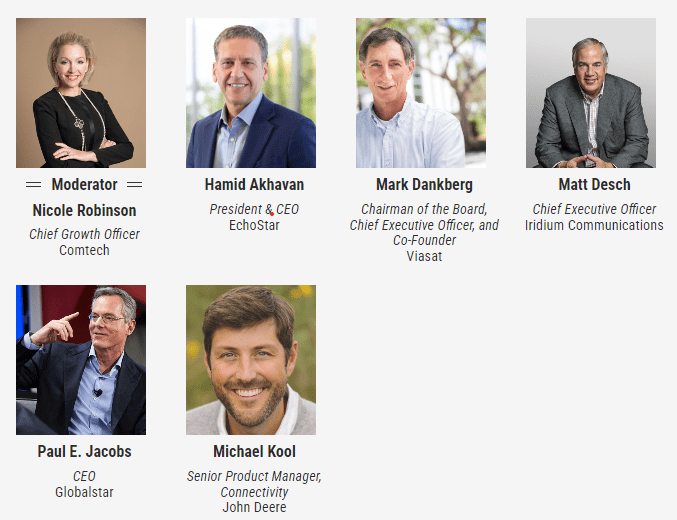Satellite 2024 conference: Are Satellite and Cellular Worlds Converging or Colliding?
Converged terrestrial and satellite connectivity is a given, but the path is strewn with unknowns and sizable technological and business challengers, according to satellite operator CEOs. Hopefully, 3GPP Release 18 will contain the necessary specifications for it to be implemented as we explained in this IEEE Techblog post.
During Access Intelligence’s Satellite 2024 conference in Washington DC this week, Viasat CEO Mark Dankberg said satellite operators must start thinking and acting like mobile network operators, creating an ecosystem that allows seamless roaming among them. Terrestrial/non-terrestrial network (NTN) convergence requires “a complete rethinking” of space and ground segments, as well as two to three orders of magnitude improvement in data pricing, Dankberg said. Standards will help get satellite and terrestrial to fit together, but that evolution will happen slowly, taking 10 to 15 years, Iridium CEO Matt Desch said. It remains to be seen how direct-to-device services will make money, he added. Satellite-enabled SOS messaging on smartphones “is becoming free, and our satellites are not free — we need to make money on it some way,” Desch added.
The regulatory environment around satellite has changed tremendously during the past decade, with the FCC very oriented toward mobile networks’ spectrum needs and now satellite matters making up most of the agenda for the 2027 World Radiocommunication Conference, Desch said. However, there will be regulatory challenges to resolve in satellite/terrestrial convergence, he predicted. There are significant synergies in having a 5G terrestrial network and satcom assets under one roof, he said. Blurring the lines between terrestrial and non-terrestrial makes it easier for manufacturers to build affordable equipment that operates in both modes, Desch concluded.
That inevitable convergence is being driven by declining launch costs, maturing technologies and improved manufacturing, all of which make non-terrestrial network connectivity more economically competitive, said EchoStar CEO Hamid Akhavan. He said the EchoStar/Dish Network combination (see 2401020003) was driven in part by that convergence, consolidating EchoStar’s S-band spectrum holdings outside the U.S. with Dish’s S-band holdings inside the country. The deal also melds Dish’s network operator expertise with Hughes’ satellite expertise.
Wednesday Opening General Session: Are Satellite and Cellular Worlds Converging or Colliding?
To ensure space’s sustainability, missions must follow the mantra of “leave nothing behind,” sustainability advocates said. Space operators should have more universal protocols and vocabulary when exchanging space situational awareness data, as well as more uniformity in what content gets exchanged, said Space Data Association Executive Director Joe Chan. When it comes to space sustainability, clutter isn’t necessarily dangerous, and any rules fostering sustainability should avoid restricting the use of space, he said. Space lawyer Stephanie Roy of Perkins Coie said a mission authorization framework covering space operations that fall outside the regulatory domain of the FCC, FAA and NOAA is needed. Space operators and investors see sustainability rules as inevitable and want to ensure they allow flexibility and don’t mandate use of any particular technology, she added. Many speakers called for a “circular economy” in space, with more reuse of materials via refueling, reuse or life extension.
Separately, space sustainability advocates urged a mission authorization regulatory framework and universal use of design features such as docking plates enabling on-orbit serving or towing. Meanwhile, conference organizers said event attendance reached 14,000.
Also, ITU Secretary-General Doreen Bogdan-Martin urged the satellite industry to join ITU’s Partner2Connect digital coalition aimed at addressing digital divide issues, particularly in the least-developed nations and in landlocked and small island developing countries. The digital divide “is right up there” with climate change as a pressing issue for humanity, said Bogdan-Martin. She noted the coalition has received $46 billion in commitments, with a target of $100 billion by 2026.
References:
https://communicationsdaily.com/article/view?BC=bc_65fb60473d5de&search_id=836928&id=1911572
ABI Research and CCS Insight: Strong growth for satellite to mobile device connectivity (messaging and broadband internet access)
SatCom market services, ITU-R WP 4G, 3GPP Release 18 and ABI Research Market Forecasts
https://www.3gpp.org/specifications-technologies/releases/release-18
2 thoughts on “Satellite 2024 conference: Are Satellite and Cellular Worlds Converging or Colliding?”
Comments are closed.




The satellite and cellular worlds are converging, integrating technologies to enhance global connectivity. This synergy aims to provide seamless, high-speed communication across diverse regions, addressing gaps in coverage and revolutionizing the future of telecommunications.
Non Terrestrial Networks (NTNs) are wireless communication systems that operate above the Earth’s surface, using platforms in the air and in Earth’s orbit. They have a number of characteristics that require adaptations in comparison to terrestrial networks, such as the motion of space/aerial vehicles. NTNs have the potential to support industrial and governmental IoT devices for a variety of verticals, including automotive, health care, agriculture, and more
ITU-R M.2514-0:
Defines requirements for satellite radio interfaces of IMT-2020, including high reliability communications, enhanced mobile broadband, and massive machine-type communications
Recommendation ITU-R M.2160-0:
Facilitates interworking between IMT radio interface technologies and non-terrestrial networks, such as satellite communication systems, HIBS, and UASs